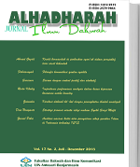Impression Flow Based on Comment in Islamic Studies from Instagram using Sentiment Analysis
DOI:
https://doi.org/10.18592/alhadharah.v20i1.3982Keywords:
Islamic Studies, Industrial Revoluton 4.0, Social Media, Instagram, Impression, Sentimen Analysis.Abstract
Islamic studies in industrial revolution 4.0 grown very rapidly. Everyone can access an information everywhere and everytime using their end devises such a smartphone and laptop base on internet access using a social media such instagram, facebook, and twitter. development of da'wah media that is not only through radio television and through studies conducted either in mosques or other places for delivering of studies and insights about Islam for all muslims in Indonesian country especially in Kalimantan Selatan. One of aplication social media for studying islam is Instagram. All of preachers is very easily make a post on Instagram for sharing a religious knowledge to users of Instagram social media, hence this case a lot of Islamic da'wah accounts in great demand by the muslims people in Indonesia. Islamic posts made by preachers on Instagram make a lot of conflict and the direction of negative or positive impressions left by users through the comments column provided from instagram. To determine the positive and negative directions of the post from a preacher. We develop a system for detecting the direction of impression from all of comment on Islamic content on Instagram created by the user using a sentimen analysis. This system analyzes comments left on a post from a preacher's Instagram story. The system that was built succeeded for classifying the filtered comments by attributing the direction of the da'wah impression posted by the preacher. The classification of the impression direction of this system contains 3 impression directions, namely positive, negative, and neutralReferences
Adinda, S. and Pangestuti, E. (2019) ‘Pengaruh media sosial instagram @exploremalang terhadap minat berkunjung followers ke suatu destinasi(survei pada followers exploremalang)’, 72(1), pp. 176–183.
Go, A., Bhayani, R. and Huang, L. (2009) ‘Twitter Sentiment Classification using Distant Supervision’, Processing, pp. 1–6.
Neal Dickert, J. (2012) ‘Abstract 17802: The Role of Cerebral Oxygenation as a Real Time Monitoring Tool in Cardiac Arrest’, Circulation, pp. 1320–1326.
Ortigosa, A., Martín, J. M. and Carro, R. M. (2014) ‘Sentiment analysis in Facebook and its application to e-learning’, Computers in Human Behavior. Elsevier Ltd, 31(1), pp. 527–541. doi: 10.1016/j.chb.2013.05.024.
Poecze, F., Ebster, C. and Strauss, C. (2018) ‘Social media metrics and sentiment analysis to evaluate the effectiveness of social media posts’, Procedia Computer Science. Elsevier B.V., 130, pp. 660–666. doi: 10.1016/j.procs.2018.04.117.
Rozi, I., Pramono, S. and Dahlan, E. (2012) ‘Implementasi Opinion Mining (Analisis Sentimen) Untuk Ekstraksi Data Opini Publik Pada Perguruan Tinggi’, Jurnal EECCIS, 6(1), pp. 37–43.
Downloads
Published
How to Cite
Issue
Section
License
Authors retain copyright and grant the journal the right of first publication, with the work simultaneously licensed under the Creative Commons Attribution-NonCommercial 4.0 International Public License (CC BY-NC 4.0). This license allows reusers to distribute, remix, adapt, and build upon the material in any medium or format for noncommercial purposes only, provided that proper attribution is given to the original creator.







